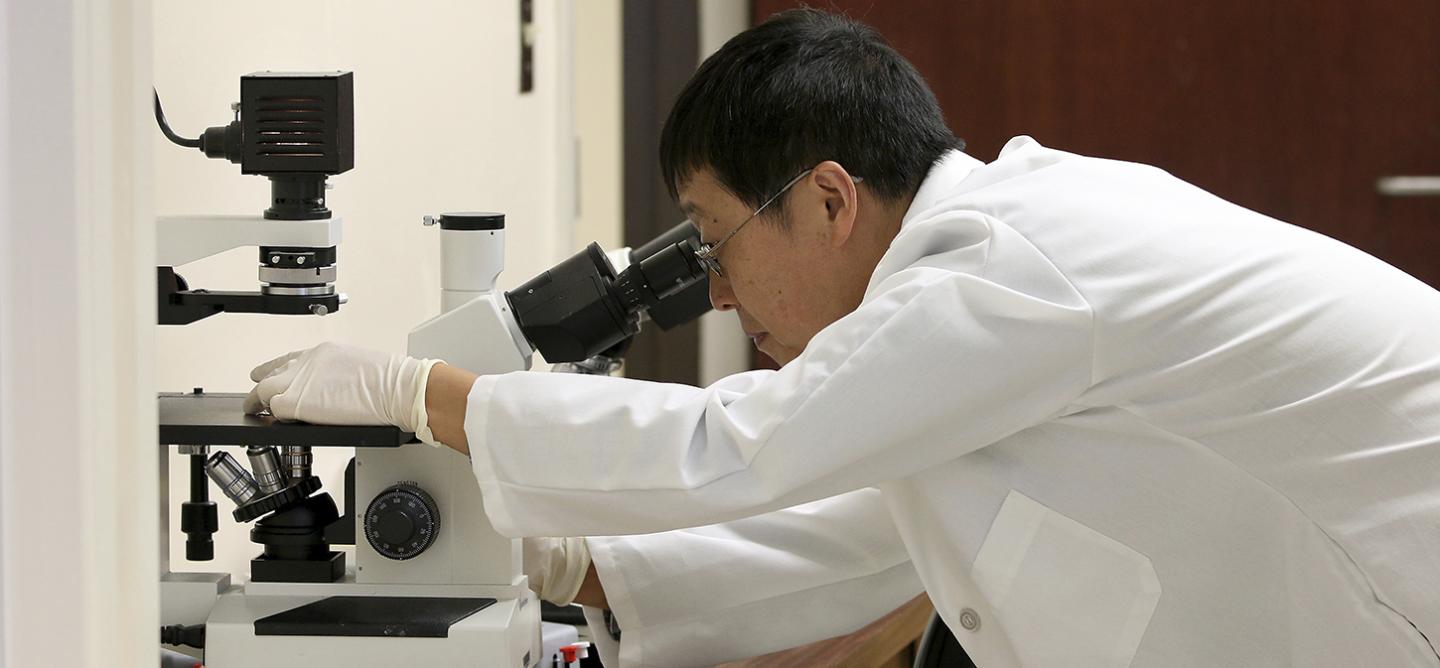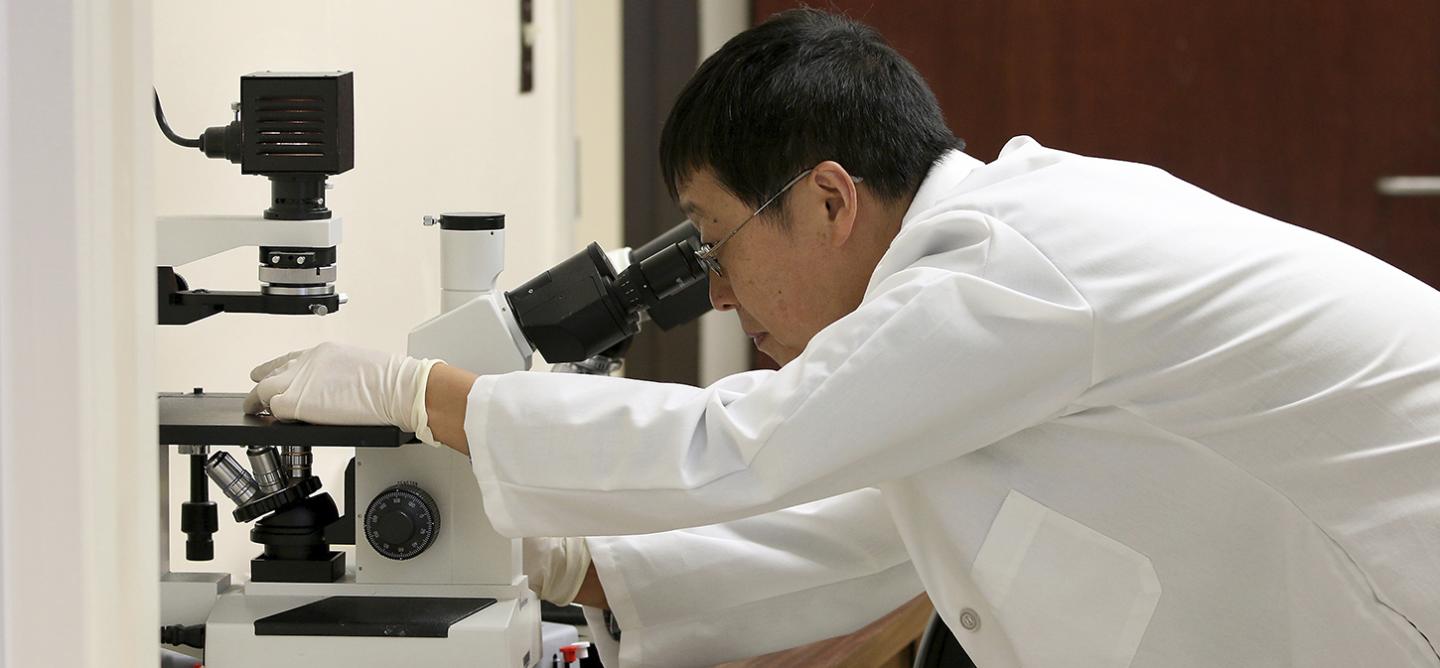
Credit: Photograph by Sarah Pack. Medical University of South Carolina.
The PIM-2 protein kinase negatively regulates T cell responses in transplantation and tumor immunity, while PIM-1 and PIM-3 are positive regulators, report Medical University of South Carolina (MUSC) investigators in an article published online on May 21, 2018 by The Journal of Clinical Investigation (JCI). Blocking PIM-2 in allogeneic bone marrow transplant (BMT) dramatically accelerated graft-versus-host disease (GVHD). In adoptive immunotherapy with autologous T cells, silencing PIM-2 on T cells produced robust tumor immunity, highlighting the importance of PIM-specific inhibition.
The PIM family of protein kinases contains three isoforms, PIM-1, PIM-2, and PIM-3, with very similar structures. Because they are known to affect cell survival and proliferation, the group is considered a promising therapeutic target in cancer. Additionally, pan-PIM inhibition (blocking all three isoforms) is often used for cancer therapy.
Because the isoforms are so similar, the assumption has been that they function in similar ways. However, in the JCI article, a team of MUSC researchers led by Xue-Zhong Yu, M.D., a professor in the Department of Microbiology and Immunology and SmartState Endowed Chair in Cancer Stem Cell Biology and Therapy at Hollings Cancer Center, showed that PIM-2 kinase has unique activity in regulating T cells that is in opposition to PIM-1 and PIM-3.
"This kinase family has been studied quite extensively in cancer biology. We know that tumors activate-or turn on–these kinases to survive better because all three isoforms help protect cancer cells from death by making them resistant to chemotherapy. That's why quite a few companies have developed pan-PIM inhibitors for cancer therapy," explains Yu.
While most research has focused on the role of PIM kinases in cancer biology, little is known about how they influence primary T cells and the immune response. Yu and his team set out to try to understand how these kinases regulate T cell responses in BMT and solid tumors.
Allogeneic BMT is an essential treatment for blood cancers such as leukemia, because, even after chemotherapy and radiation, a small number of cancer cells can remain in the bloodstream, allowing the malignancy to recur. Replacing a patient's bone marrow is the best way to prevent this, but an ideal, biologically matched donor is often not available. The less well-matched the donor, the higher the risk for developing GVHD, in which donor cells trigger an immune response that attacks the patient's normal tissues, causing high morbidity and mortality. Researchers have long sought ways to improve BMT success by reducing GVHD incidence while preserving the anti-tumor response of donor cells.
Yu's team started by testing the hypothesis that inhibiting PIM kinases would work synergistically with rapamycin, an immunosuppressant drug, to control GVHD development. Using a preclinical mouse model, they looked at how knocking out each PIM isoform, individually and in various combinations, affected GVHD induction.
"We thought that, if these kinases work in parallel, then blocking all three pathways at the same time would improve therapeutic effectiveness," explains Yu. "But when we tested each one, we saw that PIM-2 really stood out from the others and dominated the effect. We found that T cells which lacked PIM-2 had dramatically increased activation and pathogenicity to cause GVHD."
In contrast, blocking PIM-2 created highly activated, aggressive T cells for attacking cancer. "Our results in the BMT model were very robust. When we transplanted the normal number of T cells (which lacked PIM-2), the mice developed severe GVHD and died super fast-within 10 days. We had to keep reducing the T cell dose," says Yu. The team eventually found that even a dose of only 50,000 PIM-2 deficient T cells led to GVHD, whereas this number of wild-type, control T cells was incapable of inducing GVHD.
These results suggest that PIM-2 kinase plays a dominant role in regulating T cell pathogenicity in inducing GVHD and reveal a previously undefined role for PIM-2: potently inhibiting T cell alloresponses and GVHD induction. Results showed that, while PIM-2 negatively regulates T cells, PIM-1 and PIM-3 positively regulate T cell activation.
"Imagine that the therapy is a car," explains Yu. "If you want it to go faster, you can either step on the gas by boosting molecules that positively regulate the T cells, or you can remove the brakes by blocking molecules that negatively regulate the T cells. Blocking PIM-2 is like removing the brakes from a car so it then has more power to eradicate the malignancy, although at a cost of GVHD as a side effect."
Next, the team investigated PIM-2 blockade in a solid, syngeneic tumor model, transplanting cancer cells into mice that lacked PIM-2. Yu was astonished by the results. "When we injected tumor cell lines, the tumor could not grow in the PIM-2 blocked mice," says Yu. "In control mice, the tumors grew rapidly but mice without the PIM-2 molecule could completely reject the tumor. This was a big surprise. Very few molecules are so powerful."
The finding highlights the potential of PIM-2 blockade as a cancer immunotherapy.
This is the first time that the unique activity of PIM-2 kinase in T cells has been distinguished from its family members, PIM-1 and PIM-3. These findings raise concerns about pan-PIM inhibition, which may have disadvantages when the desired effect is immuno-suppression and T cell anergy. Furthermore, PIM-2 blockade may not be applicable in allogeneic BMT since it may exacerbate GVHD, whereas PIM-1 and PIM-3 blockade may alleviate GVHD.
"This study highlights the need for specific inhibitors and to exercise caution using pan-PIM inhibitors," explains Yu. "The same family of kinases can play distinct roles, so we must be more careful and understand the context of which isoforms we want to block because they may not work in a synergistic way. The lesson is that when we do scientific research, we have to keep an open mind. This kinase family has been extensively studied but we saw something completely unexpected when we studied them in different cells and different systems."
###
About MUSC
Founded in 1824 in Charleston, The Medical University of South Carolina is the oldest medical school in the South. Today, MUSC continues the tradition of excellence in education, research, and patient care. MUSC educates and trains more than 3,000 students and residents, and has nearly 13,000 employees, including approximately 1,500 faculty members. As the largest non-federal employer in Charleston, the university and its affiliates have collective annual budgets in excess of $2.2 billion. MUSC operates a 750-bed medical center, which includes a nationally recognized Children's Hospital, the Ashley River Tower (cardiovascular, digestive disease, and surgical oncology), Hollings Cancer Center (a National Cancer Institute designated center) Level I Trauma Center, and Institute of Psychiatry. For more information on academic information or clinical services, visit musc.edu. For more information on hospital patient services, visit muschealth.org.
About MUSC Hollings Cancer Center
The Hollings Cancer Center at the Medical University of South Carolina is a National Cancer Institute-designated cancer center and the largest academic-based cancer research program in South Carolina. The cancer center comprises more than 120 faculty cancer scientists with an annual research funding portfolio of $44 million and a dedication to reducing the cancer burden in South Carolina. Hollings offers state-of-the-art diagnostic capabilities, therapies and surgical techniques within multidisciplinary clinics that include surgeons, medical oncologists, radiation therapists, radiologists, pathologists, psychologists and other specialists equipped for the full range of cancer care, including more than 200 clinical trials. For more information, visit http://www.hollingscancercenter.org
Media Contact
Heather Woolwine
[email protected]
843-792-7669
@muschealthpn
http://www.musc.edu
Related Journal Article
http://dx.doi.org/10.1172/JCI95407





